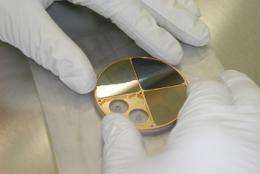Solar wind samples give insight into birth of solar system

(PhysOrg.com) -- Two papers in this week's issue of Science report the first oxygen and nitrogen isotopic measurements of the Sun, demonstrating that they are verydifferent from the same elements on Earth. These results were the top two priorities of NASA's Genesis mission, which was the first spacecraft to return from beyond the Moon, crashing in the Utah desert in 2004 after its parachute failed to deploy during re-entry.
Most of the Genesis payload consisted of fragile solar-wind collectors, which had been exposed to the solar particles over a period of two years. Nearly all of these collectors were decimated during the crash. But the capsule also contained a special instrument built by a team at Los Alamos National Laboratory to enhance the flow of solar wind onto a small target to make possible oxygen and nitrogen measurements. The targets of this Solar Wind Concentrator survived the crash and eventually yielded today's solar secrets.
"Genesis is the biggest comeback mission since Apollo 13," said Roger Wiens, a Los Alamos National Laboratory physicist and Genesis flight payload lead. "Everyone who saw the crash thought it was a terrible disaster, but instead the project has been fully successful, and the results are absolutely fascinating."
The results provide new clues to how the solar system was formed. Oxygen and nitrogen samples collected from various meteorites, as well as nitrogen sampled in lunar soil and in the Jupiter atmosphere by the Galileo probe, vary significantly from that on Earth by cosmochemical standards: 38 percent for nitrogen and up to 7 percent for oxygen. With the first solar wind samples in hand, showing the early Sun's composition, scientists can begin the game of determining where Earth's different O and N came from.
"For nitrogen, Jupiter and the Sun look the same," said Wiens. "It tells us that the original gaseous component of the inner and outer solar system was homogeneous for nitrogen, at least. So where did Earth gets its heavier nitrogen from? Maybe it came here in the material comets are made of. Perhaps it was bonded with organic materials."
For oxygen, the evidence points toward a different astrophysical mechanism called photochemical self-shielding, which the authors believe modified the composition of space dust before it coalesced to form the planets, including Earth. According to the article, the Sun shows an enrichment of pure 16O relative to Earth instead of differences in 16O, 17O, and 18O that are proportional to their atomic weight or some other mixture that doesn't show exclusive enrichment of a single isotope. This unique arrangement strongly favors the self-shielding theory, in which solar UV radiation was responsible for uniformly enhancing the two rarer isotopes, 17O and 18O, in the terrestrial planets.
The Science papers are titled "A 15N-poor isotopic composition for the solar system as shown by Genesis solar wind samples" and "The oxygen isotopic composition of the Sun inferred from captured solar wind." Wiens is among several collaborating authors on both papers, which together are cover stories for this issue. Other LANL coauthors, Beth Nordholt and Ron Moses, along with former LANL scientist Dan Reisenfeld, were all part of the team to develop and fly the Solar Wind Concentrator that provided the samples for the studies reported in Science.
And now that some of the particles flowing past Earth from the sun are in hand, "It's going to make a mission to a comet all the more interesting," Wiens said.
Provided by Los Alamos National Laboratory
















